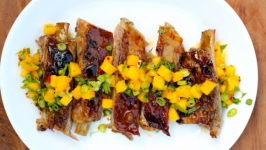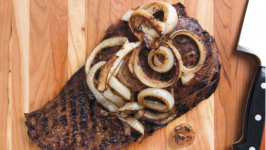Ingredients
- 2 tablespoons kosher salt
- 2 tablespoons sugar
- 2 tablespoons brown sugar
- 2 tablespoons ground cumin
- 2 tablespoons chile powder
- 2 tablespoons black pepper
- 1 tablespoon garlic powder
- 1 tablespoon onion powder
- 1 tablespoon cayenne pepper
- 1 tablespoon cinnamon
- 1 tablespoon dry mustard
- 1 tablespoon white pepper
- 1½ teaspoons coriander
- 3 tablespoons smoked paprika
- 1 bone-in pork shoulder, average weight 6–9 pounds (also called “Pork Butt” or “Boston Butt”)
- ½ cup each of cider vinegar and white vinegar
- Sugar to taste
- Red pepper flakes to taste
- Crystal Hot Sauce to taste
Preparation
Recipe courtesy of Nancy Krohngold of Nancy’s Bar-B-Q.
PREPARE THE GRILL
Any charcoal grill at least 18" in diameter with a vented dome cover will suffice. I cook with charcoal briquettes and hickorywood chunks. Build a pyramid of briquettes to one side of your grill’s bowl. You will be cooking using indirect heat—i.e., positioning the meat away from the heat source—so begin with just enough briquettes to form a single layer extending beneath half or less of the cooking grate surface area. Light the briquette pyramid, using some accelerant if desired.
PREPARE THE WOOD CHUNKS
Fill a large bowl or small bucket about halfway with water and add a half-dozen or so wood chunks to soak (oak or hickory is good). Buy wood chips if you can’t find the chunks, but the latter will burn more slowly and go farther. As with the briquettes, you will be stoking the fire with the wood chunks (one or two each time you add briquettes). During the course of the day, add more chunks as needed to the water to soak before use.
PREPARE THE RUB
Mix the dry rub ingredients together and apply the rub to the pork shoulder. Keep in mind that most pitmasters never give up the exact ingredients and measures in their recipes. You might also peruse the myriad dry rub recipes online or in cookbooks, making adjustments and adding or subtracting herbs and spices to suit your taste preferences for heat, sweet, sour, and salt.
NOTE: Be sure to wear plastic or latex gloves when mixing and applying the rub.
PREPARE AND BEGIN COOKING THE PORK BUTT
Unwrap the pork butt in your kitchen sink. One side will have a thick-ish layer of fat over it (“fat cap”). Trim off most of this with a sharp knife. Place the meat in a bowl or pan with tall sides and pat the rub well onto the entire surface area, covering all sides and top (including the fat cap) and bottom of the butt.
Check your grill: Once the coals are glowing and covered with white ash, distribute them into a single layer and place a water-soaked wood chunk on top. (It’s a good idea to place an aluminum-foil pan or tray beneath the spot where you’ll be placing the pork butt, to catch the considerable amount of fat that will drip down during the course of cooking.) Put the cooking grate in place and load the pork butt onto it, fat side DOWN and away from the burning coals. Close the dome cover over the grill, adjusting all vents so the fire never burns hotter than 250º. If your grill doesn’t have a thermostat, you may insert a cooking thermometer into one of the dome vents.
Check the fire after 60 minutes: It will probably be time to stoke it with a half-dozen briquettes (more if your grill and fire area are larger) and another water-soaked wood chunk or two. When the pork butt has cooked for 7–8 hours, flip it over so it is fat side up. Also rotate it 180 degrees to assure even cooking.
PREPARE THE FINISHING SAUCE
North Carolinians in the eastern part of their state traditionally use only this type of “finishing” sauce, which contains no tomato products. Mix all ingredients until sugar is dissolved. The sauce will keep for 2–3 days in the refrigerator.
Check the butt after 12 hours of cooking time by poking it. It’s done when it feels like a very ripe peach—and not before. Check the bone; it should be partially exposed, and if you could pull it out with a gentle tug of the tongs, the pork is done. If not, the meat needs more cooking time: replace the grill lid and test again in an hour.
When it’s ready to come off the grill, use an extra-large, heavy spatula in one hand and a silicone oven glove on the other to lift it. Take care in transferring the butt to a plate or pan. The meat will have a tendency to tear apart under its own weight. Tent it loosely with foil and let it rest for a minimum of 15 minutes before serving, if you can stand to wait. To serve, pull apart with tongs or a meat fork and pile the meat onto a plate or onto hamburger buns. Serve with East Carolina Finishing Sauce and/or your barbecue sauce of choice, some hot sauce, and your favorite slaw preparation.








